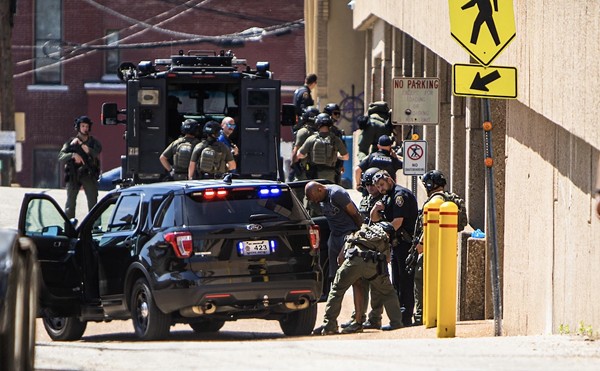Stranger still is the sight of cloistered federal bureaucrats deciding they'd better come to St. Louis and see what all the fuss is about before doing something that might terminally piss off U.S. Senator Christopher "Kit" Bond, Congressman Richard Gephardt and Mayor Francis Slay, not to mention fat-cat developers such as Steve Stogel and Craig Schnuck, the grocery-store mogul. The politicians and heavy hitters are backing the mayor's plan to tear down the Century Building to provide parking for the mayor's pet project for saving downtown -- the Old Post Office renovation.
But we're not talking about just any old building here, folks. We're talking about the Century and its equally old doppelgänger, the Syndicate Trust Building. Ain't nothin' simple or straightforward here, least of all the players. This deal has already seen its share of serious political bloodletting [Nesbitt, "Price of Thugdom," March 27].
Given this dangerous context, it was naturally prudent for a caseworker from the National Register to come here last week for a couple of luncheon meetings with Bond's folks and Slay's folks and all the other people who are drooling at the prospect of spending a boatload of public money on a project that will give St. Louis another huge garage it doesn't need.
And it was no doubt wise for these bureaucrats to end the suspense and take a stand. They did so last week, choosing to list both buildings on the National Register but deciding to list them as separate entities. This may be a distinction without a difference, but it does represent a victory for local preservationist forces who feared rank politics would overwhelm them.
But the path to this decision was a torturous one.
Before jetting to St. Louis last week, representatives from the National Register and its parent agency, the National Park Service, had two contradictory and competing proposals to consider. One nomination -- advanced on appeal after its initial rejection by the commission -- by the Landmarks Association of St. Louis called for the Century and Syndicate Trust buildings to be placed on the register as a single entity, a proposal based on the rationale that the two buildings are architecturally linked and have historically been used as one building, housing the old Scruggs, Vandervoort & Barney department store, once the city's finest, until it closed its doors in 1966.
The other nomination, advanced by the city as a de facto alternative, called for the Syndicate Trust, but not the Century, to win a listing. This would save the city the embarrassment of tearing down a newly designated national treasure.
The decision to list both buildings leaves a crucial question unanswered: Is it really necessary to tear down the Century and build another publicly funded garage within walking distance of a state-financed garage just to the north and a privately financed parking garage that will be built next to the Laclede Gas Building, about a block due south of the Century? The city's nomination also neatly sidesteps the question of whether the two buildings functioned as one, relying on the notion that the two buildings weren't connected until well after the Century was built in 1896 and the Syndicate Trust was erected in 1902.
At least the city's position has evolved. When the subject was first broached last February, the city's preservation commission, acting on a report filed by deputy mayor for development Barb Geisman and offered up for a vote by her domestic partner, Richard Callow, the board came up with a so-called split decision -- both buildings deserve historic designation, they said, but because the two had been nominated jointly, the entire block must be kept off the National Register for now because a change in historic status might jeopardize renovation of the Old Post Office and other historic buildings. Only after the Century is demolished for a parking garage would the commission revisit the status of the Syndicate Trust, the report says.
Downtown activists such as Margie Newman and Chris Thomas, who both attended the preservation-commission meeting, say the February 4 vote was rife with divided loyalties and cross-wired allegiances. In a pointed February 6 letter to Claire Blackwell, deputy state historic-preservation officer, they question Callow's failure to notify the commission about his long-standing relationship with Geisman. In separate interviews, the two activists also note that Callow has Downtown Now!, a booster of the Old Post Office plan, as a client.
"I'll never forget sitting there and thinking if ever there was a case of undue influence, this was it," says Newman, a documentary filmmaker.
Says Thomas, a past president of Metropolis St. Louis: "I am just shocked that they would spend all this political capital on this one issue. The main thrust of their argument was 'This building's coming down, and we don't want anything to upset this deal.'"
The Callow One, Slay's favorite poison-pen PR guy, says Downtown Now! was a client at the time of the vote. But he doesn't see that as a sufficient reason to recuse himself from the preservation board's vote. Because he didn't get any money from Downtown Now! as payment for his vote, his actions were aboveboard. In other words, the absence of financial gain made him street-legal: "Beyond that, as owner of a downtown business and a longtime resident of downtown, I strongly support Downtown Now!'s vision for a revitalized central business district."
In a brief biographical sketch Callow submitted at the time he was named to the preservation board by Slay in September 2001, he notes that his public-relations firm, Public Eye, is a corporate member of the Landmarks Association of St. Louis and that he is a partner in a corporation spending more than $3 million on the renovation of a historic building on Washington Avenue. Geisman is also a partner in that project, a position that earned her a soft rebuke from the Federal Highway Administration, which asked her to step down from day-to-day supervision of the Washington Avenue streetscape project because of a perceived conflict with her ownership of property that could benefit from federally funded improvements to the street.
"There was an appearance that decisions made by her could be seen as being made for her benefit. To avoid that, just don't have anything to do with the project," said Mary Ridgeway, a transportation engineer in the Federal Highway Administration's Missouri division, the office overseeing the Washington Avenue project. "We've asked her not to be involved in any of the decision-making. If there's a meeting and it comes up, maybe she should leave the room."
Asked whether he considered recusing himself from consideration of Geisman's report because he is her live-in boyfriend, Callow shoots back: "Absolutely not, and I voted with a majority of the commission on the subject. The relationship is not only well known and long-standing, it and Barbara Geisman's job are expressly listed on my official disclosure form filed with the city register. That we agree with each other on a variety of matters and that we both agree with the mayor are, in fact, reasons I am happy to serve on the Commission."
The high-profile importance of the Old Post Office project is reason enough for guys such as Bond, Gephardt, and former U.S. Senators Tom Eagleton and John "St. Jack" Danforth to flex their considerable political muscle. Even the National Register bureaucrats recognize a strong political undercurrent when they see one.
"We've heard from Senator Bond's office and Congressman Gephardt's office," says Blackwell, Missouri's deputy historic-preservation officer. "There is a high degree of political involvement because many feel that the redevelopment of the Old Post Office is critical to the redevelopment of downtown St. Louis. They feel like this is it, this is the chance to get it done. The politicians have weighed in on the side of 'Please help this move forward.'"
Blackwell and Alexis Abernathy, a spokeswoman for the National Register, make liberal use of the U-word:
"I can tell you it's highly unusual to have two nominations in hand at the same time," says Abernathy. "We handle 1,200 to 1,500 nominations a year. Normally we don't make a site visit. This is unusual -- extremely unusual."
Says Blackwell: "It is unusual to have a building nominated twice like this, but it isn't against the regulations."
Unusual or not, National Park Service bureaucrats were fêted at two dog-and-pony-show presentations on the Old Post Office plans and the vital need for the Century to be torn down so that a new garage can be built to spark development of the surrounding block -- present-day garages be damned.
Even though it's a crucial question, parking space falls outside the list of issues the National Register folks can take into consideration. Their sole question is whether the building is historic enough and architecturally significant enough to qualify for the list.
But that isn't the only consideration of some of the politicos weighing in on the issue.
"Our view is that there's a serious problem downtown with building blight," said Charlie Barnes, who runs Bond's St. Louis office. "We're willing to work with anybody wanting to address that issue. We're not wedded to any one plan, but you have a plan in place."
Bond is busy crowing about an important win for downtown St. Louis. He's also showing no shyness about claiming the credit.
Unusual, all right. But not unheard-of.





